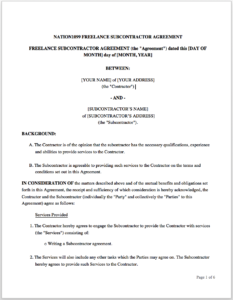Using subcontractors is a terrific way to grow a freelance business and get past the limits of hourly rates. But good documentation is crucial to reducing the headaches. This is where the value of the subcontractor agreement comes in.
We recently discussed how important it is for freelancers to protect their reputations and assets with a well-crafted freelance contract, and the same applies to when you are on the other side of the relationship.
When we subcontract, we become both a service provider and a client. This gives us a unique opportunity to earn more money while shouldering less of the work that we are less interested in or less skilled at. But it also means we have a more complex relationship to manage. (There’s a value to that, which is why it enables you to make more money.)
This article will give you a clear breakdown of the language you need in your subcontractor agreement. We also provide a number of subcontract agreement templates to help you put it all together.
A quick refresher: What’s the difference between contracting and subcontracting?
This may sound obvious, but let’s make sure we’re on the same page before going any further. Consider these definitions of contracting and subcontracting.
Contracting is when a client hires a consultant or freelancer to carry out or advise on specific projects. The relationship exists directly between the client and independent contractor.
Subcontracting is when, after a client hires an agency, company or freelancer, the hired entity pays other independent contractors to complete pieces of the work detailed in the scope of work.
Primes are the primary or lead contractor.
Subs are the subcontractor who the prime or lead agency subcontracts to.
As freelancers, many of us have experience early in our career as subs to another freelancer, consultant or agency who owns the relationship with the client.
But increasingly, freelancers are becoming the primes. We are acting like general contractors, taking on a project bigger than we can handle ourselves and then hiring other freelancers as subs in order to deliver on the contract to our clients.
We like to call this peer-to-peer freelancing, and it is actually becoming a bigger part of the overall gigs available.
Acting as a prime lets you broaden the scope of services you offer. It means you will oversee the relationships between clients and the additional talent you need to complete a contract. That puts you in the position of managing other people and managing resources.
It’s also useful here to think about the difference between a freelancer and a consultant. There is no bright line distinction, but as we discuss elsewhere, freelancing generally refers to creative work such as articles, design, photography or software code, and consulting generally refers to planning, management and strategy services.
Naturally, most of our contracts straddle work on both sides of that line. But the more you take on work that requires subcontract agreements, the more you are moving into the consulting role.
The Government Publishing Office further defines consultants as providers of “services rendered by persons who are members of a particular profession or possess a special skill and who are not officers or employees of the contractor.”
Subcontractors by comparison are general service providers who function as an “extra set of hands” under a contractor.
When you get into a prime-sub relationship, then your invoicing, proposal, time tracking and payments systems need to be up to snuff. This is a good time to consider some of the all-in-one software tools like Freshbooks or Bonsai. (Some of the new products on the market let you start on the cheap with just the features you need. Colibro is on example of that.) B
e sure to watch our toolkit page for discounts on these kinds of resources.
What’s different about the subcontractor agreement
You’ve probably noticed that many subcontractor agreements are tailored to different industries .(Plenty of them concern construction, which isn’t relevant to many freelancers).
In most cases, your subcontractor agreement will be quite similar to your freelance contract. Many standard independent contractor agreements can be easily converted into subcontractor agreements with the addition of a few specific points.

As we mentioned earlier, when you hire subs, you in effect become a client to other freelancers. Many of us are not used to this new position of responsibility.
For example, think of all the stuff about clients that annoys you like unclear assignments, change orders and fuzzy payment terms?
You are now potentially the one annoying your subcontractors.
Related reading: Better Protect Your Time and Work with a Client Sign-Off
The details and the subcontractor templates below will get you thinking about the new factors you need to consider now that you are in the role of a client.
Terms unique to the subcontractor agreement:
• No breach of contract clause: Are any of your potential subcontractors working for an employer who might contractually prevent them from working with you (or cause you harm for hiring them)?
• Necessary conditions for starting work: If one of your clients requires errors and omissions insurance, are your subcontractors covered or will they commit to be by a certain date?
• Terms of payment outline (how and when): You may not wish to pay your subcontractors in the same way you ask to be paid. What do you deem to be a fair, scalable compensation for them?
• Termination clause: It’s important that your subs know that, while they are ultimately accountable to you, your client has the right to terminate your work with them at any time. Therefore, you need to make sure that you can end your agreement with the sub in a reasonable time to control your expenses.
• Work for hire clause: We’re used to seeing this directed toward us, but don’t forget to apply this same clarification to the subcontractors in your agreement.
Bare essentials of the subcontractor agreement
A good subcontractor agreement (and most good freelance contracts as well) should cover these basic expectations for both sides:
• Who is providing the service?
• Who is receiving the service?
• What service/services are being provided?
• What is the payment structure?
• If payment is on an hourly basis, what is the hourly rate?
• Will the subcontractor agreement include reimbursement for expenses? If so, which qualify?
• Does your subcontractor require a deposit?
• When do you pay your subcontractor/how often?
• Do you need to provide the subcontractor with any resources for them to carry out their work? When do you need provide them with these resources? You may need them from your client.
• Who will own the work under this subcontract agreement?
• Does the subcontract agreement acknowledge authorship of their work?
• When does the agreement end?
• Which factors terminate the subcontract agreement? Can either party do so at any time?
• What is the signing date?
Special conditions for subcontractor contracts
Many of us begin using subs because we’ve changed our client mix and need to adapt to the demands these new projects require.
For example, maybe as a freelance software developer, you’ve taken on a product development job. You may need to bring in other freelance coders and UX designers that you subcontract to.
Or maybe you are a freelance graphic designer who has been asked to be the freelance art director, so you will need to sub to other designers and photographers.
While the terms below won’t apply to all clients, these are good points to think about.
• Is a confidentiality clause necessary?
• Will a no-compete clause be necessary?
• Will a no-hire clause for your other subcontractors or client’s employees be necessary? (Could a high level subcontractor you work with be tempted to hire other members of your team or your client’s employees?)
• Who is legally liable to the client for underperformance?
• Does the subcontractor need insurance?
• Will an A-133 audit be necessary? (Is one of your clients a city/state/nonprofit working with $500,000 or more of federal funding each year? If so the government wants to know exactly where the money is going).
Our subcontractor agreement template
We’ve put together a basic subcontractor agreement template below that you can download, plug your necessary information into and use immediately.
Review it thoroughly with your attorney before using it and revise to it suit the needs and conditions of your project.

Other good subcontractor agreement templates to review:
Independent Consulting Bootcamp‘s Subcontractor Agreement
Stanford University‘s Subcontract Agreement
Portland VA Research Foundation‘s Independent Subcontractor Agreement
National Institute of Governmental Purchasing‘s Subcontractor Agreement
U.S. Department of Health and Human Services offers a comprehensive explanation of “business associate contracts” in the delicate of health information privacy.
The National Academies of Sciences, Engineering and Medicine has templates for subawards and amendments for government grants and contracts.
Society of Human Resource Management (aka SHRM) provides a bare-bones contractor agreement.
AIGA provides an excellent workbook and toolkit to create contracts and agreements for designers.
The Printing Industries of America has an easy-to-read template for subcontractor agreements. This one clearly covers the issue of non-compete clauses.
Teaming agreements are a variation on subcontracting, particularly when it comes to bidding on government contracts. Check out this template for how to organize that.
Same Day Transcription‘s Independent Subcontractor Agreement
For best results, customize your subcontractor agreement
You don’t need to start from scratch. A subcontractor agreement template that you’ve familiarized yourself with will more likely than not get the job done.
It goes without saying that no two subcontracted projects are exactly the same, and you will need to take the unique elements in your scenario into consideration in your subcontractor agreement.
Get started now:
- Begin with either our subcontractor agreement template or one of the others provided above.
- Fill in the necessary information in the prompted areas.
- Make a list of important factors you don’t feel are covered.
- Craft the necessary language you need to accommodate these additional terms.
- Work these terms into your own customized subcontractor agreement.
- Consult your lawyer.














Hi Ben — great article and a SO useful! I’ve actually had my consulting practice for 13 years and built most of my experience/generated most of my income from sub-contractor relationships. A couple of tricky areas I’ve encountered: 1. the sub’s unique skills and who is the “resident expert” on an engagement. The prime often brings me in because I know something they don’t! (smile) 2. Prime/sub Branding: while I am 100% on board with representing my prime and their interests, given my #1, I am questioning the wisdom of my branding being completely “silent” in the engagement cycle. Not meant to undercut the prime at all, but ensuring the client knows the nature of the relationship — there may be opportunities there for referrals to the prime and the sub.
Great points Dora. On #2, I’m thinking of all the advice I’m hearing when I listen to podcasts about the “agency” world, which often partner with one another or sub to individuals or to other agencies. It seems like the trend there lately is, “The client doesn’t care who is doing it or whose name is on it.”
In the old days, there was a fear that if the client knew the primary was subbing out part of the work their reaction would be, ‘What are we paying you so much for if you’re not doing the work?” So they buried the sub.
My sense is that isn’t a concern so much from the client’s point of view anymore. Hopefully, primaries get that and let the sub get their branding in there more than in the old days. The attitude ought to be to sell the partnership as an advantage instead of acting like it’s a dirty secret.
Personally, I’m the primary hiring subs more than the reverse, and I try to be a strong advocate for my subs, encouraging my clients to give them credit, use their bylines, link to them, etc. It works both ways. When the subs feel included, they root for the success of the project, sharing it, etc.
I also insist that unbylined or uncredited work does not mean white label. My subs should be able to include this work in their portfolio and to claim credit for their role in it.
I love your philosophy on this Robert — I’ve got two primes with whom I’ve had a decade-old relationship; we’ve built the relationship you’ve described over time. Interestingly just started a new relationship with a different prime and I’ve found myself educating them on the points you’ve outlined because this is their first time partnering with an experienced consultant (which leads me to a series of articles I’m working on — more to come on that!) I’m just discovering Nation1099 and it’s a fantastic resource! I’ve talked with at least a 1/2 dozen people in as many months who have started their own businesses or are ready to make the leap. I IMMEDIATELY refer them to this website because this content and community wasn’t available when I started out as a consultant and the advice and tools are invaluable and for someone who’s been in it for a while, N1099 offers a fresh perspective! – I look forward to collaborating with you and fellow 1099ers!
Thanks so much Dora. One quick example of the benefit of this approach that came up just the other day . . . A project that my sub and I worked on months ago went live last week. We were long ago paid and have moved on. But we are both credited by name on the project and would feel invested in its success in any case.
So in the last few days we have cheerfully been circulating the project and promoting as avidly as if it were part of our contract to do so. For instance, I was to put the project in the inbox of the CEO of a major vendor in our industry and a prospective partner to our original client — along with a note to keep me in mind if they ever need services like ours. And I have no problem with my sub doing the same. This is one upside to the client (and to me as the client of the sub) of not getting so uptight about white labeling, poaching or lines of communication.